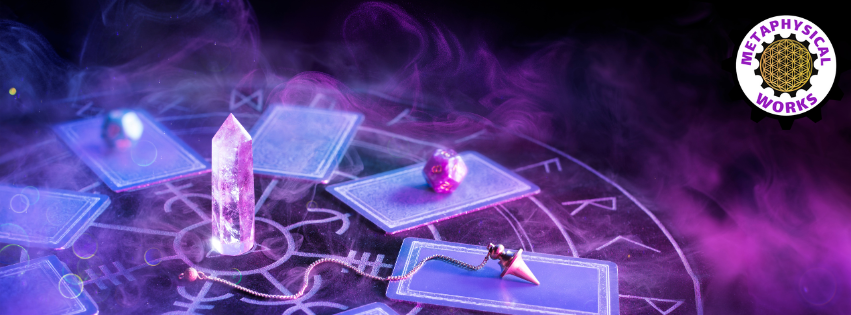Divination: What Is It? (Plus How to Use Pendulums, Tarot Cards, Runes & Oracle Decks)
By Shane Hudgins
Apr 1, 2025
Add a comment
Throughout history, humans have turned to the art of divination to seek clarity, guidance, and a deeper understanding of the unseen forces shaping their lives. Whether through the casting of bones, drawing of cards, or movement of a pendulum, divination offers a sacred dialogue with the universe.
In this guide, we’ll explore the meaning, purpose, and origins of divination, followed by expanded, practical instructions for working with four powerful tools: pendulums, tarot cards, runes, and oracle cards. Each method provides a unique lens through which to receive spiritual insight and awaken intuitive wisdom.
Part I: What Is Divination?
Divination is the metaphysical practice of seeking knowledge, guidance, or prophecy by interpreting signs, symbols, or intuitive impressions. It’s not about predicting the future with certainty, but about illuminating possibilities and gaining clarity on the present moment.
The Purpose of Divination
- Insight: To understand inner truths and external influences.
- Connection: To communicate with higher self, Spirit, ancestors, or divine forces.
- Empowerment: To make informed, aligned decisions.
- Healing: To bring hidden emotions and blocks to light.
Divination can be deeply personal, sacred, and transformative. When used with respect and intention, it becomes a trusted tool on your spiritual journey.
Part II: How to Use a Pendulum for Divination
Historical Roots: The use of pendulums dates back to ancient China, Egypt, and Rome, where they were employed in dowsing to locate water, minerals, and lost objects. Over time, pendulums evolved into spiritual tools for divining truth and detecting subtle energies.
A pendulum is a weighted object (often a crystal) suspended from a chain or cord. It responds to subtle energy and can answer yes/no/maybe questions based on directional movement.
Steps:
- Cleanse Your Pendulum – Use moonlight, smoke, or intention to remove lingering energy.
- Establish the Signals – Ask: “Show me Yes,” “Show me No,” “Show me Maybe.” Observe the direction of swing (e.g., front to back, side to side, circular).
- Ground & Center Yourself – Take a few deep breaths and set a clear intention. This ensures your energy is stable and focused.
- Ask Clear Questions – Yes/no questions work best. Avoid emotionally charged or vague phrasing.
- Interpret Movements – Let the pendulum respond naturally without forcing motion. Trust the intuitive flow.
- Close with Gratitude – Thank the energy and spirit guides you’ve worked with.
Tip: Metaphysical Works offers crystal pendulums like amethyst and clear quartz that enhance clarity and energetic sensitivity.
View our Pendulums Collection to see all the beautiful options.
Part III: How to Read Tarot Cards
Historical Roots: Tarot cards originated in 15th-century Europe as playing cards. It wasn’t until the 18th century that they became associated with divination and mysticism. Influenced by Hermeticism and the Kabbalah, tarot grew into a powerful symbolic language of spiritual insight.
Tarot is a structured system of 78 cards, including the 22 Major Arcana (spiritual archetypes) and 56 Minor Arcana (daily life influences). Each card carries layered meaning and symbolism.
Steps:
- Choose Your Deck – Find one that resonates with your energy. Art style, symbolism, and deck theme matter.
- Cleanse Your Deck – Use smoke, moonlight, selenite, or knock three times on the deck to clear energy.
- Set an Intention – Before you shuffle, ask your guides for clarity, truth, and wisdom.
- Shuffle & Draw Cards – You can use a single card draw, a 3-card spread (past/present/future), or more complex layouts like the Celtic Cross.
- Interpret the Cards – Begin with traditional meanings, but tune into your intuitive impressions. The imagery often speaks beyond the guidebook.
- Journal the Reading – Reflect on how the message applies to your life, emotions, and current challenges. Track recurring patterns.
Tip: Metaphysical Works carries beginner-friendly tarot decks, intuitive workbooks, and journals to help you cultivate a deeper practice.
View our Tarot Decks Collection to find the one that speaks to you.
Part IV: How to Use Runes for Divination
Historical Roots: Runes are an ancient alphabet known as the Elder Futhark, used by Germanic and Norse peoples as early as 150 AD. These symbols were carved into wood, bone, or stone and served both practical (writing, marking property) and mystical (divination, magic) purposes.
Each rune holds an energetic frequency and message. Casting or drawing runes is like conversing with the wisdom of the ancestors.
Steps:
- Cleanse the Runes – Pass them through incense smoke, lay them on a selenite slab, or state your intention aloud.
- Ask a Clear Question – The clearer your question, the clearer the guidance. Focus inward.
- Draw 1 to 3 Runes – Reach into the bag or bowl without looking. Allow your hand to hover and select intuitively.
- Interpret the Symbols – Refer to rune meanings, but also listen to the story they tell together. Pay attention to upright vs. reversed (merkstave) runes.
- Record the Reading – Note the question, runes drawn, and your reflections. Over time, your personal interpretations will deepen.
Tip: Explore rune sets carved into wood, quartz, or obsidian at Metaphysical Works—each set handcrafted with reverence and intention.
View our Runes Collection to find the best set for your practice.
Part V: How to Work with Oracle Cards
Historical Roots: Oracle cards emerged in the 19th century as an intuitive alternative to tarot. Unlike tarot’s fixed structure, oracle decks are freeform and expansive—each deck shaped by the creator’s vision, theme, and spiritual lineage.
Today, oracle cards range from angelic guidance to animal spirit decks, goddess energy, plant allies, and cosmic themes. They’re ideal for daily inspiration, emotional check-ins, and spiritual affirmation.
Steps:
- Choose a Deck That Speaks to You – Explore themes that align with your energy or current spiritual focus.
- Cleanse & Bless Your Deck – Hold it close to your heart and breathe intention into the cards. Use moonlight or sound cleansing if desired.
- Ask a Question or Invite a Message – Try, “What message do I need today?” or focus on a specific area of your life.
- Draw 1 to 3 Cards – Allow your hand to move gently over the deck. Trust your pull.
- Interpret the Imagery & Message – Observe symbols, colors, and feelings before consulting the guidebook. Your intuition is the first teacher.
- Keep a Daily Oracle Journal – Writing your thoughts builds connection and clarity. Look for synchronicities.
Tip: Metaphysical Works curates oracle decks featuring diverse artists, inclusive themes, and nurturing messages—ideal for both beginners and seasoned seekers.
View our Oracle Cards Collection to discover all the possibilities.
Final Thoughts
Divination is more than a method—it’s a sacred invitation to know yourself, align with Spirit, and co-create your path. Whether you’re drawn to pendulums, tarot, runes, or oracle cards, trust that the wisdom you seek is already within you.
Ready to explore the tools of divination? Visit our Divination Tools Collections to discover ethically sourced divination tools and guidance for your spiritual journey.
May your divination practice be a dance of light and mystery, clarity and connection—one card, one symbol, one truth at a time.

